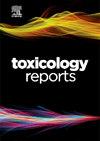The protective effect of coadministration of coenzyme Q10 and vitamin E on myopathy induced by simvastatin in rats
Q1 Environmental Science
引用次数: 0
Abstract
The use of Simvastatin has been reported to induced muscle myopathy, with no effective preventive measures. The study objective is to study the protective effect of CoQ10, vitamin E, and their combination to prevent simvastatin-induced skeletal muscle myopathy in rat models and explore possible mechanisms by measuring muscle biomarkers and histopathological changes. All rats (n = 49) received 80 mg/kg/day of simvastatin to induce myopathy for 30 days, the study includes 7 groups (n = 7): negative control, CMC and cotton seed oils vehicles, simvastatin induction, CoQ10, vitamin E and combination of vitamin E and CoQ10 groups; rats in the intervention groups received either 100 mg/kg CoQ10 or 40 mg/kg vitamin E or their combination once daily orally for 30 days. At the end of the experiment, rats were euthanized by cervical dislocation, and blood and the collected tissue samples were collected to measure creatinine kinase (CKM), malondialdehyde (MDA), total antioxidant capacity (TAOC), inducible nitric oxide synthase-2 (iNOS2), and aldolase. In addition, gastrocnemius muscle histopathology was examined. Treatment with CoQ10, vitamin E, or their combination significantly reduced the levels of CKM, aldolase, iNO2, and MDA and increased TAOC compared to the simvastatin induction group. The combination group showed a superior protective effect than either drug alone. Treatment with vitamin E and CoQ10 showed mild vacuolation and cytoplasm with focal splitting and fragmentation of muscle fibers, scattered central nuclei, and eosinophilic cytoplasm. In conclusion, CoQ10 and vitamin E combined showed a superior protective effect against simvastatin-induced myopathy through antioxidant and antiapoptotic pathways.
辅酶Q10和维生素E对辛伐他汀所致大鼠肌病的保护作用
辛伐他汀的使用已被报道诱发肌肉肌病,没有有效的预防措施。本研究目的是通过测量肌肉生物标志物和组织病理学变化,研究CoQ10和维生素E及其联合使用对辛伐他汀诱导的骨骼肌肌病大鼠模型的保护作用,并探讨可能的机制。所有大鼠(n = 49)均给予80 mg/kg/天辛伐他汀诱导肌病30 d,研究分为7组(n = 7):阴性对照、CMC和棉籽油对照、辛伐他汀诱导、辅酶q10、维生素E及维生素E和辅酶q10联合组;干预组大鼠每天口服100 mg/kg辅酶q10或40 mg/kg维生素E或其组合一次,持续30天。实验结束后,取颈椎脱位致大鼠安乐死,取血及组织标本测定肌酐激酶(CKM)、丙二醛(MDA)、总抗氧化能力(TAOC)、诱导型一氧化氮合酶-2 (iNOS2)、醛缩酶。同时进行腓肠肌组织病理学检查。与辛伐他汀诱导组相比,CoQ10、维生素E或其联合治疗显著降低CKM、醛缩酶、iNO2和MDA水平,并增加TAOC。联合用药组的保护作用优于单独用药组。用维生素E和辅酶q10处理后,细胞质出现轻度空泡化,肌肉纤维局部分裂和断裂,中心核分散,细胞质嗜酸性。综上所述,CoQ10和维生素E联用通过抗氧化和抗凋亡途径对辛伐他汀诱导的肌病具有较好的保护作用。
本文章由计算机程序翻译,如有差异,请以英文原文为准。
求助全文
约1分钟内获得全文
求助全文
来源期刊

Toxicology Reports
Environmental Science-Health, Toxicology and Mutagenesis
CiteScore
7.60
自引率
0.00%
发文量
228
审稿时长
11 weeks
 求助内容:
求助内容: 应助结果提醒方式:
应助结果提醒方式:


